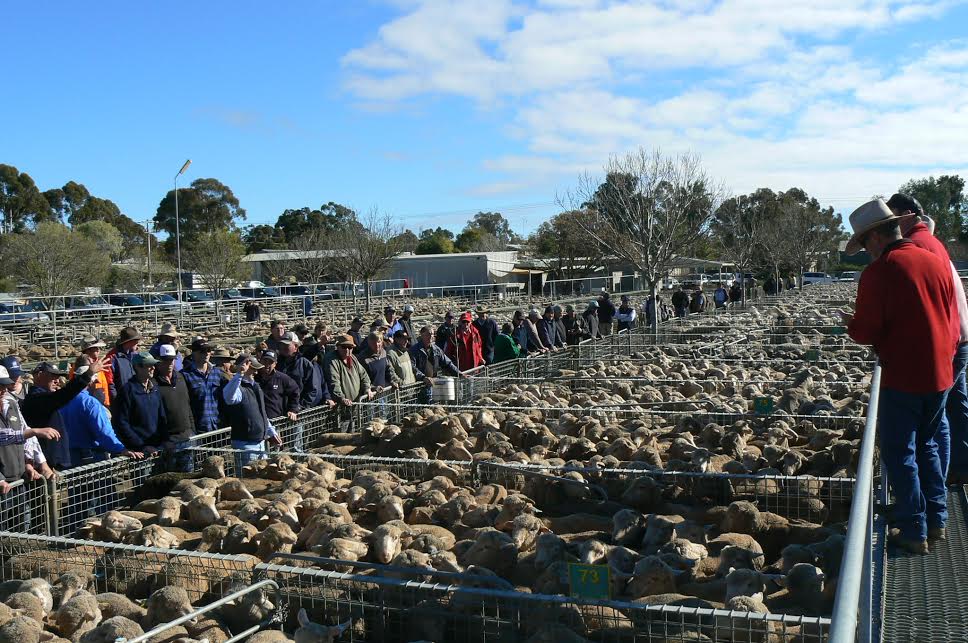
Lambs being sold at the Ouyen saleyards.
CONTINUING COVID-19 workforce restrictions on Victorian meat processors could potentially create a backlog of lambs that would enter the market and extend downward pressure on prices, a Rural Bank analysis has found.
The insight update found that Spring will be a painful time for Victorian lamb producers who have experienced the best season in years after multiple years of drought, but were likely to receive weaker prices from reduced buyer competition at saleyards due to the restrictions.
Despite some increases in recent weeks, the eastern states trade lamb indicator (ESTLI) has already fallen 27 percent from 936c/kg in early June to 681c/kg yesterday. Downward pressure on lamb prices is expected to continue to increase as lamb supply increases towards a peak in October and November, the bank said.
The Rural Bank said producers are expected to hold onto lambs in response to low prices, as was seen in August when average weekly lamb yardings declined 9pc month-on-month in Victoria, contrary to the national trend of a 14pc increase. Retention of lambs would create a backlog of lambs which could be turned off in a hurry once feed supplies deteriorate in Summer, it said.
Current restrictions on meat processing facilities
As of midnight on 7 August 2020, Victorian abattoirs with more than 25 staff have not been able to operate with more than 67pc of daily peak and daily total workforce capacity, affecting 120 facilities in the state. Daily peak workforce capacity equals the daily average of the highest number of workers on site at any given time on each day over July 2020, or in any three-month sequential period in the last 12 months. Daily total workforce capacity equals the daily average of the total number of workers on site at any given time on each day over: July 2020, or any three-month sequential period in the last 12 months.
Under the current Victorian Government Coronavirus (COVID-19) roadmap to reopening released on 7 September 2020, meat processing will remain “heavily restricted” through the first, second and third steps, although the recent lowering of the rolling 14-day regional case average could change this. Third step restrictions were initially set to ease on 23 November conditional upon there being zero new COVID cases for more than 14 days.
Effect of restrictions on lamb processing would be severe
Victoria is a significant processor of Australian livestock, processing 52pc of all lambs and 40pc of the nation’s sheep. However, the nation is generally in a low supply period after good rainfall this year allowed producers to retain stock after multiple years of drought-induced destocking. The Rural Bank said this has left Australia’s cattle herd at 24.6 million (lowest since 1992) and Australia’s sheep flock at 63.5 million (lowest in over a century).
The bank said cattle and mutton will be least affected by restrictions on Victorian processor workforces due to forecast tight supply for the remainder of 2020 from depleted herds and flocks and the focus on stock retention for rebuilding numbers. However, lamb will be severely affected by restrictions on Victorian processor workforces as Spring is the peak supply period for lambs and there is an expected increase in lamb supply in 2020 due to favourable seasonal conditions increasing lambing rates and lamb survival.
Australian lamb slaughter in September-December 2020 is forecast to be 4.5pc higher year-on-year and 6.6pc above the five-year average. Victorian lamb slaughter is forecast to peak at just over 1 million head in October and November, in line with seasonal trends and the current season forecast. Slaughter in each of these months is expected to be 46pc higher than June slaughter, the bank said.
If processors opt to calculate workforce capacity based on any three-month period in the last 12 months, it would likely be during the peak supply period of October-December 2019. During this period, average weekly lamb slaughter in Victoria was 199,999 and 67pc of this slaughter rate equals 133,999 lambs per week. The average weekly slaughter rate in August 2020 was 133,056, the bank said.
The Rural Bank said lamb slaughter rates may creep a bit higher as processors continue to mitigate the effects of the reduced workforce by spreading the reduced workforce over more shifts (including weekends) and/or by utilising available capacity in New South Wales, South Australia or Queensland.



HAVE YOUR SAY